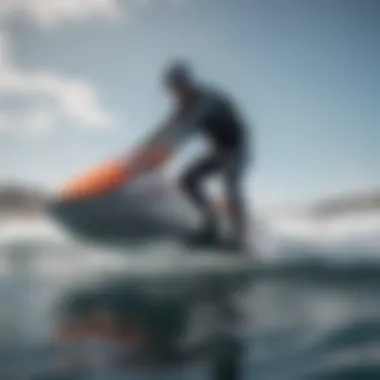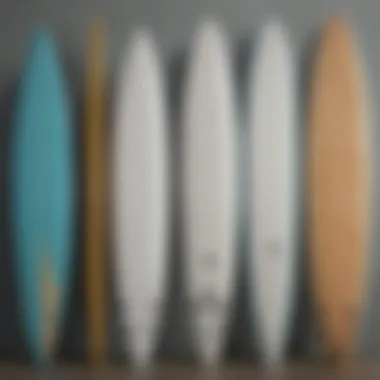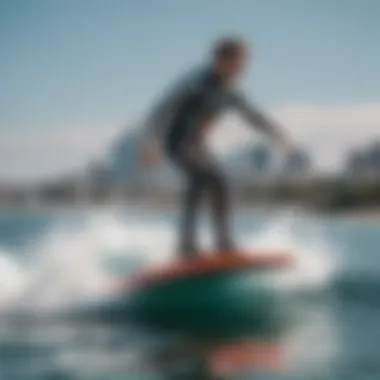Understanding Hydrofoil Surfboards: A Deep Dive


Intro
Hydrofoil surfboards have gained quite the buzz in the kiteboarding community. However, understanding the essential mechanics behind these boards is crucial for anyone looking to harness their potential on the water. This article dives deep into how hydrofoils operate, what makes them tick, and the importance of proper gear selection and skill development. By unpacking the layers of hydrofoil design and function, enthusiasts can fine-tune their approach, leading to a more exhilarating and efficient riding experience.
Gear Selection
Selecting the right gear is vital for anyone venturing into the world of hydrofoil surfboarding. The equipment you choose influences not only your performance but also your overall enjoyment and safety on the water. Here, we’ll discuss types of kites and the importance of choosing the right board.
Types of Kites
When it comes to hydrofoil surfing, kites come in all shapes and sizes, each tailored for specific conditions and riding styles. Here's a look at some notable kite types that can complement a hydrofoil:
- Delta Kites: Known for their stability and easy relaunch, these kites are a favorite among beginners. They offer consistent power, making them great for learning the ropes.
- C-Kites: More aggressive and designed for performance, these kites deliver higher lift and speed. They are better suited for experienced riders aiming for tricks and jumps.
- Bow Kites: They have a larger wind range and offer better depower, allowing riders to adjust their speed and power quickly. This adaptability makes them a solid choice for varying conditions.
Choosing the right kite hinges on your skill level, the typical wind conditions you face, and your riding objectives. Remember, a good kite not only enhances your ride but keeps you safe while you're at it.
Choosing the Right Board
Finding a board that pairs well with your chosen kite is another piece of the puzzle. Hydrofoil boards are designed differently compared to standard surfboards:
- Size and Volume: A larger board provides more buoyancy, which is beneficial for beginners who need extra stability while learning. As you progress, you may opt for a smaller board which allows for quicker turns and more responsiveness.
- Foil Compatibility: Ensure that the board you select is compatible with the hydrofoil you intend to use. Mismatched components can lead to subpar performance and safety concerns.
- Material and Construction: Boards made from high-quality materials like carbon fiber or epoxy can withstand the rigors of hydrofoil surfing. They are often lighter and provide better feedback, enhancing maneuverability.
When selecting your gear, always keep in mind that it's about synergy; how your kite, board, and foil work together influences your overall performance on the waves.
"The right combination of gear can make or break your hydrofoil experience. Take the time to choose wisely."
Skill Development
Once your gear is sorted out, the next step is to develop the skills necessary for effective riding. Hydrofoiling can present challenges, but with the right techniques and progression tips, you can elevate your capabilities.
Essential Techniques
To enjoy hydrofoil surfing fully, mastering a few key techniques is essential:
- Balance: Maintaining your center of gravity is crucial for controlling the board. Stay light on your feet and adjust your body position as needed.
- Weight Distribution: Shifting your weight helps control the lift and depth of the foil beneath the water. Lean back during takeoff and forward when you want to drop down or increase speed.
- Turning Techniques: Start practicing smooth, gradual turns. Abrupt movements can destabilize the board, especially when learning.
Progression Tips
Getting comfortable with your hydrofoil requires practice, but here are some helpful tips to smoothen your progress:
- Start Small: Begin by practicing on flat water with minimal chop. Gradually progress to rougher conditions as your confidence builds.
- Visualize: Before attempting new moves, visualize the motions in your mind. Imagine the steps you need to take; this can make them feel more attainable when you practice.
- Ride with Others: Finding a community or a partner can help. Watching how others ride can provide insights into techniques you may not have considered.
With the right gear, skills, and community support, mastering hydrofoil surfing can turn into one of the most rewarding experiences in the kiteboarding world. Embrace the learning curve, and before you know it, you’ll be gliding above the water with ease.
Foreword to Hydrofoil Surfboards
Understanding hydrofoil surfboards offers an essential look into a rapidly evolving segment of watersport technology. These boards lift above the water, gliding effortlessly, and their increasing popularity reflects their unique benefits for surfers, kiteboarders, and watersport enthusiasts alike. This section aims to illuminate the fundamental aspects of hydrofoil surfboards, including their design, functionality, and how they enhance the surfing experience.
Overview of Hydrofoils
At their core, hydrofoils use a submerged wing, or foil, to create lift. This allows the rider to soar above the water's surface, significantly reducing drag and enabling smoother navigation through choppy sea conditions. The thrill of riding on a hydrofoil transcends traditional surfing; enthusiasts often describe feeling as if they're flying above the waves.
But let’s break it down a bit further. Hydrofoils consist of two main parts: the board itself and the hydrofoil assembly attached to the underside of the board. The hydrofoil assembly consists of a mast, wings, and stabilizers. This setup means your board can ride on the thin layer of air created by the lift, making it ideal for various water conditions.
For those new to hydrofoils, learning to ride can feel like learning to walk again. Finding balance on the board as it lifts can take practice. However, once you get a hang of it, that initial wobbliness gives way to the exquisite sensation of gliding. It’s like catching a wave but without that familiar struggle against the swell.
Those who have tried hydrofoil surfboards often mention how they can ride in lighter winds and smaller waves. So, for kiteboarders, using a hydrofoil can extend your riding sessions into conditions that might traditionally be deemed unrideable. If you’re looking to enhance your skills and add another layer to your watersport repertoire, hydrofoiling is a worthy pursuit.
History of Hydrofoil Technology in Surfing


The journey of hydrofoil technology is rich and quite fascinating, tracing back several decades. The concept was first explored in the early 1900s, with various inventors playing around with foils for boats and even aircraft. But it took quite some time for this technology to transition into the surf community.
In the 1960s, enthusiasts and inventors began experimenting with foils designed for surfing. As innovative minds tinkered with this technology, the surf culture slowly started to embrace the idea of riding above the waves. The first commercially viable hydrofoil surfboards started showing up in the early 2000s, paving the way for advancements in design and materials.
With time, companies began to refine hydrofoil design, making them more accessible and easier to ride. Riders began to find a community, sharing tips and techniques that fostered experimentation and development. This collaborative spirit only enhanced the sport, further bridging the gap between traditional surfing and this innovative approach.
The evolution continues today, with manufacturers introducing lightweight materials and advanced engineering methods. Innovations in hydrofoil design have made boards not only more durable but also more responsive.
In essence, the history of hydrofoils in surfing is not just about mechanics; it's a testament to the spirit of innovation within the watersport community. It reminds us of how a simple idea, when fanned by passion and experimentation, can lead to revolutionary changes in how we experience the ocean.
How Hydrofoil Surfboards Function
Understanding how hydrofoil surfboards function is foundational for both enthusiasts and professionals in the water sports community. These boards operate on principles of physics that differentiate them markedly from traditional surfing methods. Hydrofoil surfboards create a unique riding experience by efficiently lifting above the surface of the water, which minimizes resistance and opens the door to new possibilities in performance. It’s essential to delve into key elements that contribute to their functionality, along with the specific benefits they offer and considerations that a rider should keep in mind.
Basic Principles of Hydrodynamics
At the heart of hydrofoil surfing lies the concept of hydrodynamics, which pertains to the interactions between fluids (like water) and solid bodies (like surfboards). When a hydrofoil board moves through water, it displaces the fluid around it. The shape of the hydrofoil is designed to create a pressure difference on either side of its wing as it glides through the water. The foil’s design and angle significantly influence the amount of lift it generates.
In simpler terms, as the board speeds up, the hydrofoil cuts through the water, generating lift by leveraging Bernoulli's principle. This principle states that an increase in the speed of a fluid occurs simultaneously with a decrease in pressure. This phenomenon allows hydrofoil surfboards to rise above water, thus allowing for smoother rides and enhanced speeds.
Lift and Drag Forces
The interplay of lift and drag forces forms the operational basis of hydrofoil surfboards.
- Lift is the upward force generated as water flows over and under the foil. To achieve this, the foil must be angled correctly, a technique known as the angle of attack.
- Drag, on the other hand, refers to the resistance the board encounters as it moves through the water.
Maximizing lift and minimizing drag is crucial for efficient hydrofoil surfing. A well-balanced approach enables the rider to optimize lift without creating excess drag. Riders must gauge their position and movements carefully to maintain this delicate equilibrium. When mastered, this balance translates to higher speeds and the ability to navigate through varying wave conditions effortlessly.
Role of the Foil and Mast
The foil and mast are integral components of a hydrofoil surfboard, working together to deliver a fluid surfing experience.
The foil itself typically consists of a wing, fuselage, and stabilizer. The wing is the primary source of lift, while the stabilizer helps maintain stability and control. Each aspect is engineered with precision to ensure effective maneuverability in the water. The material composition of the foil impacts its buoyancy, flexibility, and overall performance.
Meanwhile, the mast connects the foil to the board and elevates it above the water’s surface. Its length influences the height at which the board rides. A longer mast might provide a smoother ride over choppy water but requires more skill to maneuver safely. Conversely, a shorter mast allows for quicker adjustments but may hinder performance in rougher seas.
The combination of the optimal foil design and appropriately chosen mast height contributes to a rider's overall control, comfort, and efficiency on the water.
Components of a Hydrofoil Surfboard
The construction of hydrofoil surfboards is not just a matter of aesthetics or brand preference; it’s essential to comprehend how various components function and interact to enhance overall performance. Each segment—board, hydrofoil assembly, and bindings—plays a pivotal role in dictating the ride experience. Knowing these intricate details can significantly contribute to making informed choices, whether you're a beginner or a seasoned rider.
The Board: Design and Materials
The board is more than just a platform to stand on; it is a integral component that greatly influences how well the hydrofoil functions. Commonly made from materials such as epoxy resin, fiberglass, and sometimes carbon fiber, these choices have implications on weight, durability, and flexibility.
The design of the board itself can vary widely. A shorter board generally offers better maneuverability, allowing for quick turns and swift direction changes. Conversely, a longer board tends to provide increased stability, especially for those still finding their balance. The width also matters—wide boards can offer better floatation, but narrow boards may enhance speed.
In terms of weight, a lighter board can improve responsiveness, while a heavier one might give a more stable ride. Over the years, advancements in materials have led to the development of honeycomb structure boards which offer significant strength without adding extra weight.
Understanding the Hydrofoil Assembly
The hydrofoil assembly is essentially the heart and soul of the setup. Made up of the mast, wings, and fuselage, each of these parts does its bit to ensure you soar above the water. The mast connects the board to the foil and varies in length. Shorter masts offer a more connected feel to the water, making it easier for beginners. However, experts often prefer longer masts, as they allow for smoother rides over chop and waves.
The wings are crucial in generating lift—without them, you wouldn’t be flying high above the surface. Bigger wings generally provide more lift but can result in drag at higher speeds. Thus, selecting the right wing size is key to matching your skill level and riding conditions.
The fuselage acts as the central unit where the wings attach. Its length and shape also influence performance; a shorter fuselage can lead to quicker turns, while a longer one offers stability at higher speeds. Understanding how these components blend together allows you to optimize your hydrofoil setup for unique riding styles.
Bindings and Safety Gear Considerations


Bindings serve a multifaceted role; they not only secure your feet to the board, but also play into the overall safety and ease of use. Traditional bindings provide solid foot support and are beneficial for freestyle maneuvers. Conversely, strapless riding, which is gaining popularity, can offer a sense of freedom but demands higher levels of skill and control.
Safety gear is paramount, especially when venturing into unfamiliar waters. A helmet is a must-have, as it protects against potential accidents. Impact vests or flotation devices can also provide an added layer of security, allowing you to focus on mastering your technique.
A few essential safety tips include:
- Always check your gear before heading out.
- Familiarize yourself with local water conditions.
- Make sure someone knows your planned route and ETA.
In summary, a comprehensive understanding of each component is imperative for enhancing not only performance but rider safety. By paying attention to the specific characteristics of the board, hydrofoil assembly, and binding choices, you'll be better prepared to tackle the waves and make the most of your hydrofoil surfboarding experience.
"Knowing your gear is like knowing your craft. It can make all the difference in the water.”
With these insights, kiteboarders, instructors, and enthusiasts can feel more empowered to choose and maintain their hydrofoil surfboards, leading to safer and more enjoyable sessions on the water.
Riding Techniques with Hydrofoils
Riding techniques with hydrofoil surfboards are the heart and soul of mastering this unique sport. Unlike traditional surfing, where the board largely remains on the surface, hydrofoiling involves elevating the board above the water. This change in dynamics means that the techniques you need to employ are different and can feel a bit more complex at first. However, once you get the hang of it, you'll find that riding a hydrofoil can be an exhilarating experience that opens up new possibilities in the water.
Getting Started: Balance and Positioning
The first step to riding a hydrofoil is understanding balance and positioning. When you first step onto a hydrofoil, it might feel a bit like standing on a seesaw, wobbly and uncertain. Here are a few key points to consider:
- Foot Placement: Position your back foot further towards the tail of the board. This helps you generate the necessary lift, making it easier to get out of the water. The front foot should be more central but not too far forward; you want a solid base for balance.
- Body Position: Lean slightly forward when you start to ride. This helps to keep the nose of the board down, making it easier to control the foil. Keep your shoulders parallel to the board, which aids in maintaining balance.
- Use Your Core: Engaging your core is crucial. Not only does it help stabilize your body, but it also assists in making adjustments mid-ride when you feel off-balance.
With practice, feeling balanced will become second nature. As one user on reddit pointed out, "You just have to ride it like you own it!" It’s all about finding your groove, and that comes with time.
Tips for Smooth Takeoffs and Landings
Takeoffs and landings are perhaps the most critical parts of hydrofoiling. The mechanics behind them will make or break your ride main points here include:
- Starting from a Standstill: While in a sitting position or kneeling, begin by gently pushing forward and pulling on the tow line. As you feel the water lift you, gradually shift your weight back and unbend your knees.
- Using Speed for Takeoff: You need not to rush; using some initial speed is key. As you gain momentum, slowly shift your weight back and allow the board to rise. The faster you go, the easier it gets to lift off.
- Soft Landings: Landing a hydrofoil often feels like trying to land a helicopter rather than a plane. Approach the water with a slight downward angle at your nose. Let the front of the hydrofoil touch the water gently first to avoid a rough touchdown.
- Keeping Pressure in Your Feet: While in the air, maintain equal pressure in both your feet. This stabilizes your control over the board during both takeoff and landing.
Many surfers especially enjoy the contrast of smooth takeoffs and effortless landings it's a blend of skill and finesse that can be deeply satisfying.
Turning and Maneuvering on a Hydrofoil
Turning and maneuvering on a hydrofoil might seem daunting at first, but once you understand the principles, it’s quite a thrilling experience. Some crucial points to consider are:
- Shift Your Weight: To initiate a turn, lean towards the direction you want to go. Shifting your weight on the board helps to guide the foil, making a smoother transition.
- Small Adjustments: It’s all about subtle movements. Larger shifts can result in abrupt changes that might throw you off balance. Instead, be gentle with your inputs for smoother turns.
- Use the Foil’s Lift: Keep in mind that the hydrofoil is designed to lift you above the water, which can enable sharper turns. Use that lift to your advantage by steering into your turn.
- Follow the Flow: Be aware of the surrounding water and flow. The currents can significantly impact your maneuvers, so adapt to your environment for better control.
As a fellow hydrophilic rider said, "It feels a bit like dancing on water," capturing the grace and rhythm that becomes a part of hydrofoiling.
Learning these techniques is not just about the mechanics; it’s also a way to connect with the water. With patience and practice, you’ll find your own style emerge, allowing you to carve through the waves effortlessly in no time.
Advantages of Hydrofoil Surfboards
Hydrofoil surfboards have been making waves in the water sports community, and for good reasons. Their design and function bring a host of advantages that can. quite literally, lift a surfer's experience to new heights. This section dives into the key benefits of using hydrofoil surfboards, outlining their performance in diverse conditions, the efficiency they bring, and their lower environmental footprint compared to more conventional surfing options.
Performance in Varying Conditions
One of the standout features of hydrofoil surfboards is their ability to maintain performance across a wide range of water conditions. Traditional surfboards often struggle in smaller waves or choppy waters, yet hydrofoils excel where others falter. With a hydrofoil, the board hovers above the water surface as it’s propelled by the rider’s speed. This mechanism allows for gliding effortlessly over the surface, even in less-than-ideal conditions.
- Versatility: Whether it’s knee-high swells or windy days, riders can enjoy a smooth ride. Even a gentle breeze can get you moving.
- Greater Force Utilization: The hydrofoil allows riders to convert more of the wave's energy into propulsion. This extends the ride and increases the time spent gliding without needing strong wave action.
- Paddle Power: An experienced rider can paddle into a wave that may not be sufficient for traditional surfing, enhancing the riding experience overall.
Enhancements to Speed and Efficiency
Speed is another arena where hydrofoil surfboards outshine their traditional counterparts. When a rider stands on a hydrofoil, they create lift, moving the board above the water, thereby dramatically reducing drag. This efficient design results in several key enhancements:
- Higher Speeds: Riders frequently report achieving speeds that are difficult to match with regular surfboards. This advantage can lead to exhilarating experiences as riders harness the full potential of the wind and waves.
- Energy Conservation: With less water resistance, riders expend less energy overall. This reduction can lead to longer sessions without fatigue setting in quickly.
- Early Planing: Hydrofoil surfboards allow for an earlier planing effect compared to traditional boards, meaning riders can get up to speed sooner.


Reduced Environmental Impact Compared to Traditional Surfboards
As eco-consciousness becomes more prevalent among outdoor enthusiasts, hydrofoil surfboards are emerging as a more sustainable choice. Traditional surfboards often utilize materials that can be harmful to the environment. In comparison, hydrofoil surfboards often incorporate more eco-friendly materials in their construction. The following points highlight their reduced impact:
- Sustainable Materials: Many manufacturers are opting for eco-sensitive materials such as recycled plastics or sustainably sourced woods, lessening the ecological footprint.
- Durability: Hydrofoils tend to be more durable, meaning they have a longer lifespan. This longevity helps minimize waste from broken or discarded boards.
- Promoting Clean Water Sports: By being able to ride with less dependence on perfectly clean, large waves, hydrofoil surfers contribute to promoting the responsible use of oceans and waterways.
Hydrofoil surfboards are carving out a niche in the watersport world, ensuring both performance and environmental responsibility. The blend of high speed, versatility, and sustainability makes them a compelling option for surfers everywhere.
In summary, hydrofoil surfboards offer a plethora of advantages that appeal to a wide demographic within the water sports community. Whether it’s the performance they deliver, the efficiency they promote, or their reduced environmental impact, it’s clear that hydrofoils are not just a trend but a significant advancement in surfing technology.
Safety Considerations in Hydrofoil Surfboarding
When venturing into the world of hydrofoil surfboarding, safety ain’t just an afterthought; it’s paramount. This thrilling sport carries its own set of risks due to the height of the foils and the dynamics at play. Understanding the safety considerations helps in enjoying the ride while mitigating risks. Grasping this aspect not only ensures a more enjoyable experience but also encourages a culture of safety within the community. Here’s a closer look at key elements that demand attention for anyone pursuing this electrifying sport.
Common Risks and Precautions
Every water sport has a few skeletons in the closet—hydrofoil surfing is no exception. Some common risks involved include:
- Falling: With the board rising above the water, falls can happen unexpectedly and from significant heights. Falling onto the foil can lead to serious injuries.
- Collisions: The movement and speed attained while riding can lead to collisions with other water users or obstacles.
- Water Conditions: Variable water conditions can dramatically change the safety equation. Choppy water, currents, or shallow areas can pose hidden dangers.
Precautions include:
- Practicing in controlled environments before heading into more challenging waters.
- Always keeping a close watch on others in the vicinity while riding.
- Ensuring equipment is well-maintained to prevent mishaps related to gear failure.
Staying mindful of these risks can keep you from being caught off guard when the unexpected strikes.
Protective Equipment: What You Need
Dressed for success can mean something quite different in hydrofoil surfing, and having the right gear is non-negotiable. Here’s what you should consider:
- Helmet: A solid helmet can protect the head in case of falls or collisions.
- Impact Vest: This not only adds a layer of safety but can also make falls slightly less jarring.
- Wetsuit: Helps with buoyancy and provides warmth, especially in colder waters. It can also protect against abrasions if falling.
- Leash: Ensuring your board doesn’t run off without you is essential. A quality leash tethered securely can save a lot of trouble.
It's about making sure you have the right tools to keep you safe while you glide through the waves.
Understanding Water Conditions and Impact on Safety
Water can be unpredictable, and understanding how it behaves is crucial for a safe hydrofoil experience. Factors to consider include:
- Wave Height and Frequency: Bigger waves can lead to more turbulent conditions. If they come in quick succession, they can catch you off guard.
- Water Depth: Shallow waters pose a risk, especially when attempting some stunts. Being mindful of the depth can save you from serious harm.
- Wind Conditions: High winds can create challenging conditions, making control harder. With hydrofoil boards, a sudden gust can send you flying if you're unprepared.
"Always keep one eye on the horizon; the water can change in the blink of an eye."
Finale: The Future of Hydrofoil Surfboards
As the landscape of water sports evolves, hydrofoil surfboards are more than just a fleeting trend. They represent a significant shift in how enthusiasts engage with the ocean, blending technology with the sheer joy of riding waves. This article illustrates that the future isn’t simply about maintaining pace within the industry; it’s about pushing the boundaries of performance and experience for both novices and seasoned riders alike.
Innovations on the Horizon
Looking ahead, the hydrofoil surfboard market is poised for exciting developments. Advances in material science promise lighter, stronger compositions which could improve performance across varying conditions. The integration of smart technology, such as sensors to monitor speed and stability, could enhance real-time feedback during rides, making it easier for riders to hone their skills.
- Electric-assisted hydrofoils: These are likely to gain traction, allowing riders to experience hydrofoiling in flatwater, far away from wave breaks.
- Enhanced safety features: New designs may include automatic cut-off mechanisms for hydrofoils to minimize accidents, crucial for inexperienced riders just kicking off their journey.
These innovations are beatin' a path not just for recreational use but could also pave the way for competitive events that elevate the sport even further into the public eye.
Growing Community and Resources
The rise of hydrofoil surfing is coupled with a vibrant, expanding community. Social media platforms like Facebook and Reddit have birthed groups where enthusiasts share tips, tricks, and personal stories of triumph and fails alike.
- Skill-sharing: Local clubs are sprouting up, offering classes taught by veteran riders who know the ins and outs of the sport. This kind of grassroots spirit fosters camaraderie and a sense of belonging.
- Online resources: Websites dedicated to hydrofoiling, such as dedicated forums and instructional videos, are becoming invaluable assets for those looking to learn or improve. They demystify the mechanics involved and create a clearer path for aspiring hydrofoilers.
These elements combined indicate a promise for hydrofoil surfboards that stretches far beyond just the product. They contribute to a greater culture of inclusivity, helping to bridge gaps between varying levels of experienece and expertise in the sport.
"As we chart a course through the future of hydrofoil surfboards, it’s clear we’re not just riding on water; we’re creating waves that future generations will feel and ride for years to come."
In summation, the journey forward seems bright for hydrofoil surfboards. Through continuous innovation and a community-oriented approach, the sport stands ready to embrace an ever-wider audience while enriching the experience for everyone involved.















